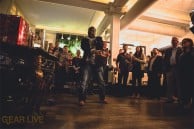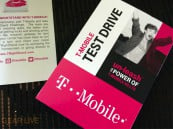Latest Gear Live Videos
Tuesday March 3, 2009 12:49 am
WATCHMEN WEEK: Where Were You in 1986? Part 1
Alan Moore’s and Dave Gibbons’ Watchmen #1 went on sale in June 1986, nearly 23 years ago. It’s forgotten by a lot of recent converts, but back then there were no internets to get the word out or issue spoilers or post and host endless debates. Solicitation copy wasn’t quite the artform it is today, and the Watchmen issues came out every month (more or less) – you couldn’t just order the whole thing off Amazon like you can today. There was also no “wait-for-the-trade” guarantee back then. You had to wait for each new issue to tease its way into the marketplace. If you missed an issue, you had to scramble. Moore and Gibbons had to create a compelling-enough story to hold the audience every 30 days over a 1-year period. Over at Mike’s Amazing World of DC Comics, you can see what other comics DC released around the same time. Many of them proved to be not quite as compelling.
We all have memories of where we were when great events took place. You might remember your first computer, your first iPod, your first car, the first time you spoke to a woman dressed as Silk Spectre or a man dressed as Nite Owl. Comic book industry types of the Watchmen/Dark Knight era certainly remember where they were when Watchmen #1 debuted. I asked them to share…
GARY GUZZO: I had my comic shop Amazing Tales, and was down at my distributor, Comics Unlimited in Staten Island picking up that week’s comics. No one delivered then. There were multiple distributors. You could just go to the warehouse and see the stuff you were picking up, which was cool since the distributor had extra inventory and if something looked good, you could potentially increase your order on the spot. Almost made up for the stuff you had to take since you ordered it, especially painful in the age of the black and white glut. The book was very well-received and anticipated at Amazing Tales. The regulars were waiting at the door when I got back to the shop (a regular thing, but greatly amplified by Watchmen). We sold out that day. Then, weeks of discussion followed….
(Gary Guzzo is living in exile on the coast of Maine after years of collecting comics, retailing comics, advising for the Overstreet Price Guide, and working for high profile comics publishers. Gary and his wife Dawn have run a local advertising and design agency, Atomic Studios, for the last ten years and are poised to return to comics in 2009 with some high profile projects.)
DAVE OLBRICH: When Watchmen #1 was released, I was on the frontlines. I was in the front row for the show. I was in the catbird seat. I was a customer service representative for a direct market comic book distributor in Los Angeles. I saw the boxes arrive on the loading dock. I helped retailers get the copies that they needed for their customers ... and I helped them get more copies when they ran out. I answered retailers’ panicked calls when their copies of Watchmen #1 sold out. Reading Watchmen was a joy, but being an important cog in the machine to make sure others got to read it was really fun.
(Dave Olbrich was the founding Publisher of Malibu Comics. In between games of Madden Football, he runs his own blog, Funnybook Fanatic.)
CARL POTTS: In 1985 I’d been editing at Marvel for a couple of years. While visiting Howard Chaykin in Los Angeles, he mentioned that he’d seen Xeroxes of an amazing new series that Alan Moore was writing and Dave Gibbons was drawing. Chaykin felt the series was going to be groundbreaking. Howard is not easily impressed so he got my expectations up. When the first issue showed up in my comics bundle in 1986, I picked it out first and I was not disappointed. The plot and dialogue were captivating and took super heroes into new territory. Also, I’d always had a nostalgic affection for the Charlton characters so it was intriguing to see them in this new guise. Gibbons’ wonderful art managed to be contemporary while also echoing a ‘60s visual storytelling esthetic. As impressed as the comics readership and professional ranks were with Watchmen at the time of its release, I don’t think any of us could have anticipated the long-term popularity that the series has enjoyed. Over two decades later, Watchmen collections still fly off the shelves. Chaykin was right. Watchmen was - and is - amazing.
(Carl Potts is a Creative Director/Artist/Writer. He is a former Executive Editor at Marvel Comics and EIC of Epic Comics. He runs his own blog called General Eclectic.)
GORDON PURCELL: I was a big Dave Gibbons and Alan Moore fan, so I was really looking forward to the first issue of Watchmen—and wasn’t disappointed! The first issue is especially fine, setting up the tale and the world perfectly. I was working for a Twin Cities comic shop at the time (I wanted to get into comics, so working in a comic store made sense to me) and was really on top of what the fans were excited about. As the series came out, the local pros started really going over the issues in long discussions similar to how we would later discuss The X-Files or Lost. It’s those discussions I enjoyed most, and the book—even with its shipping problems—was a big part of my early pro days!
(Freelance comic book artist Gordon Purcell just finished the Star Trek: The Last Generation mini-series from IDW and is starting a monster story set in ancient Rome called Beyond The Wall, also for IDW.)
PAUL O’CONNOR: I am hazy on June 1986, as I am on the entire decade, but I’m certain this was dead-center in my hardcore comic fan time, distinct from when I had to scare up quarters to buy them as a kid, and distinct from my “pro” period when I was writing for Malibu, and all the joy went out of being a fan, and I walked away from reading comics pretty much for good. But when Watchmen came out I was mainlining a hundred bucks a month via direct mail from Westfield Comics, filling out triplicate forms a month ahead of time to get my books at 20% off (or something like that). I bought into Watchmen entirely because of Alan Moore. The concept didn’t interest me at all ... but I thought that Swamp Thing was the greatest run I’d ever read and would eagerly have purchased anything he was writing at the time. I read each book as it came out, usually first out of the box, but never spiraled down too deep into it. I don’t think I read them more than once, and I certainly haven’t read them since. Enjoyed them, but didn’t love them. Was influenced by them, certainly (my own first series, Liberator, was a “revisionist superhero” strip aping Alan Moore). Bought the graphic novel at comicon last summer because I couldn’t be bothered to dig my original books out of wherever-the-hell-they-are but haven’t summoned up the will to read it yet. Will certainly see the film but it’s not like I’m counting down the days.
(Paul O’Conner is the Brand Director at Appy Entertainment and the big kahuna of Appy’s blog.)
KIM HOWARD JOHNSON: Back in June 1986, I was part of the Chicago Improv scene, part of the first house team of the Improv Olympic, and being directed by the legendary Del Close. It was an amazing time, and lots of the folks that were around at the time have gone on to bigger things—folks like Mike Myers, Bonnie Hunt, Joel Murray, Tim Meadows, and a whole lot more. I like to take the credit for re-introducing Del to comic books (along with John Ostrander), and he fell in love with Alan Moore’s Swamp Thing and Frank Miller’s Dark Knight Returns. We both saw the ads for Watchmen, and patiently waited for that first issue. On the day it finally came out, I dutifully picked up an extra copy for Del and dropped it by his house, just down the block from mine. At our next performance, Del was like a kid, and we excitedly discussed the nuances of each sequence, just as we would for the next 11 issues. In the years after that, Del theorized that comic books were an art form that had yet to deliver its first true masterpiece—but Watchmen was as close as we had come. Today, it’s hard to argue with that. When Del died ten years ago, he left me his slipcased Graphitti Watchmen hardcover, which I can look up and see on my shelf as I type this. Somehow, this seems like an appropriate time to pull it down and commence another re-reading…
[Writer and Monty Python scholar, Kim “Howard” Johnson is the author of the Del Close biography, The Funniest One in the Room, and the new Python book, Monty Python’s Tunisian Holiday.)
LOU BANK: For me, June 1986 wasn’t the summer of Watchmen—it was the summer of Jolt Cola. I was 20 years old, into my third month running a start-up Glenwood warehouse in an industrial park on the outskirts of Ft. Lauderdale, and, as Michael Martens is fond of saying, busy as a one-legged man in an ass-kicking contest. Because I was too green to know how to hire good help, or too arrogant to believe anyone could help, I only hired three employees, retaining none of them more than a few weeks. Instead, I did everything myself. Working seven days a week, I outfitted the warehouse, checked in stock, took orders, processed orders, ran deliveries, did inventory, kept the books ... everything. All by myself. And Thursdays? Here’s how Thursdays looked: I’d do a full 8:00-to-8:00 on Wednesdays; head home with the client order sheets, where I would manually (this was before computers, remember) put together the pull sheets for the next day’s new comics delivery, usually until 1:00 or 2:00 in the morning; meet the shipment at the airport around 10:00 the next morning; check-in the stock (which involved counting every copy in every box—I was OCD about missing one or two copies, as though the cost of that was somehow less than the cost of the time it took to count the tens of thousands of comics received); pull and box the orders; tag some of the orders to go out via UPS; exchange boxed comics for payment with those (most) who picked up their orders; and write up any reorders they pulled from warehouse stock. It was usually 5:00 or 6:00 in the evening by the time that was done. Then I threw into my van the comics ordered by stores in Daytona, Orlando, Winter Haven, Lakeland, and, when I was lucky enough to get the business, Tampa ... and a number of points in between that I’ve erased from memory. It was usually 1:00 or 2:00 in the morning before I was done. Sometimes I would shotgun Jolt Cola and mainline Cheetos to fuel the drive back to Sunrise; sometimes I would crash in a $25-a-night fleabag. Either way, I was back at the warehouse the next morning by 9:00 to receive calls about a missing copy of this, or a damaged copy of that ... all of which is to say, I never actually read Watchmen. Didn’t read it then because I didn’t have the time. (A photocopy of Paul Chadwick’s first “Concrete” story, which I loved, is the only thing I do remember from the period.) Didn’t read it later because I was annoyed that the issues came out so sporadically. I mean, hey!, here I was busting my ass to get the comics to the stores! The least the writers and artists could do was get the comics out on time. When they were late, I had to spend countless phone calls hearing from store owners how these delays were ruining their business. And because Watchmen was one of the biggest comics of the time, I had to hear about that one a lot. As a consequence, I associate the series with pain and aggravation—like a Pavlovian dog, but salivating with rage, not hunger. So I’ve never read, never will read it, and sure won’t see the movie. But, hey, loved the artwork!
(Lou Bank went from that Glenwood warehouse to the sales department at Marvel, then to Dark Horse, then fled the comics industry. One of his great joys now is working with crime-fiction novelist Andrew Vachss, who has never been late with anything, and whose 18th and final Burke novel, Another Life, is in stores now.)
SHAUN McLAUGHLIN: Back in June 1986, I was still at home, with a twin bed and comics that numbered somewhere between a buttload and a whole bunch. I have no idea how I heard about Watchmen. It’s hard to remember how such things were communicated before the advent of the Internet. I believe paper and conversation were involved. I knew Dave Gibbons from Green Lantern and had heard a lot of people talk about Swamp Thing, but horror was never my bag so I wasn’t overly familiar with Mr. Moore. My memories of first reading Watchmen #1 have to do with the charm of discovery. In a pre-blog age when every fart of every creator wasn’t recorded and shared from site to site, I got to buy it and read it and actually be surprised. It was the glory of discovery I found so captivating that nothing in comics has equaled it since.
(Shaun McLaughlin did a bunch of stuff at DC, a bigger bunch of stuff at Warner Animation and is about to reboot a major animation franchise.)
AARON LOPRESTI: I was in film school at USC living in Los Angeles. I saw the whole happy face button thing with the drip of blood (or so I thought) on it, and I just didn’t get it. I was rejecting Alan Moore at the time because everybody was saying how great he was and I wanted to be a non-conformist. In typical Aaron Lopresti fashion, I didn’t pick up the issues until about three years later after they had gone up in price and won all kinds of accolades. I was surprised and amazed at how good it was. But I will say I have never liked the ending. I thought it was too much of a stretch, but the character stuff along the way was outstanding.
(Among his many other talents, Aaron Lopresti is the artist for DC Comics’ Wonder Woman and author of Fantastical Creatures Field Guide: How to Hunt Them Down and Draw Them Where They Live. You can read a recent interview with Aaron right here.)
Thanks everyone for playing along. Tomorrow, we’ll be back with Where Were You In 1986? Part Two as Watchmen Week continues!
WATCHMEN WEEK, PART 2
WATCHMEN WEEK, PART 3
WATCHMEN WEEK, PART 4
(artwork © DC Comics, Inc.)
Advertisement
Advertisement
Advertisement
© Gear Live Media, LLC. 2007 – User-posted content, unless source is quoted, is licensed under a Creative Commons Public Domain License. Gear Live graphics, logos, designs, page headers, button icons, videos, articles, blogs, forums, scripts and other service names are the trademarks of Gear Live Inc.













Comments: